Table of Contents
Peacock Cichlids Overview
Peacock cichlids are scientifically referred to as aulonocara nyassae and are members of the cichlidae family. You can find them predominantly in freshwater lakes; most of the species inhabit the lake of Malawi.
Twenty species of peacock cichlids are estimated to live in lake Malawi, a lake found in the Rift Valley in Africa. The peacock cichlid is one of the most popular freshwater fish among aquarists worldwide, and therefore the lake is known as the lake of the peacock cichlid.

| Information Chart | Peacock Cichlids |
|---|---|
| Scientific Name: | Aulonocara nyassae |
| Family: | Cichlidae |
| Care Level: | Easy-Medium |
| Temperament: | Aggressive |
| Color: | Vibrant purple, yellow, orange, red, blue, pink, gold |
| Lifespan: | 6–8 years |
| Size: | Medium (4-6 inches) |
| Diet | Omnivore |
| Minimum Tank Size: | Medium-Large |
| Temperature: | 76–82°F (24–28°C) |
| Water Conditions: | Hardness: 4–6 dGH |
| Tank Mate Compatibility | Placidochromis, Copadichromis, Sciaenochromis, Nyassachromis |
Peacock Cichlids Appearance
Peacock cichlids exist in various bright colors like yellow, red, blue, pink, gold, orange, and purple and live in freshwater lakes.
The male cichlids appear in bright colors and slightly different shades than females.
Female peacock cichlids exhibit fewer colors when compared to males. These species do not change color during mating.
In addition, the colors exhibited by these fishes enhance your aquarium look, thereby adorning the overall look of your home/office and continuously making heads turn.
Types Of Peacock Cichlids
Peacock cichlids occur in many different types. There have been 22 species discovered so far, and in this guide, we will walk you through a couple of them, depending on their popularity.
Red Peacock Cichlid

The red peacock cichlids, also scientifically known as aulonocara jacobfreibergi. It is one of the most attractive species and famous for its sparkly red color. Another important attractiveness is its fin, which constitutes a scattered bluish pattern alongside the fins.
OB Peacock Cichlid

Surprisingly, it’s an artificial hybrid of OB female mbuna (rock dweller) and a male aulonocara. This fish body is red-colored with dark blue patches on its skin. These patches are visible brighter on the face than on the dorsal fins.
Blue Peacock Cichlid

Like its name, this fish’s body is crystal blue and covered with a lustrous sheen. The body is covered with blue color with vertical stripes on the fins similar to that of a peacock. Color variations are seen based on age, gender, and location.
Strawberry Peacock Cichlid

The strawberry peacock cichlid appears stunning with bright reddish-pink color. It steals the show with blue stripes on its fins and white dots scattered on its skin.
Dragon Blood Peacock Cichlid

Strawberry peacock cichlids and dragon peacock cichlids look similar; the only difference is the dotted spots on their skin.
The lifespan of Peacock Cichlids
The typical lifespan of a peacock cichlid is 6 years. If you properly maintain the recommended conditions, water parameters, diet, breeding, and quality, the fish can live up to 8 t0 10 years.
Peacock Cichlids Size
Peacock cichlids typically grow up to 4 inches on the lower end and 7 inches for larger specimens. Some cichlids grow up to 8 to 10 inches but depend on the tank’s location, size, etc.
Natural Habitat and Origin
You can mainly find these species in 2 regions of the African nations, Malawi and Tanzania. The Malawi Lake, located in the Rift Valley region, houses a freshwater lake.
It is the ninth-largest water lake and acts as an optimum source for the growth of peacock cichlids.
The substrate or habitat required for the growth is sand or rocks. The lake fairly maintains the temperature of 72° Fahrenheit, and at the surface, the temperature is 75° and 84°.
Peacock cichlids go to the tank bottom to hunt for food from the sand. These fishes actively participate in swimming in search of food.
Peacock Cichlids Care & Tank Set-Up
As the cichlids swim continuously for food, you should know minimum information about the tank size, shape, and how many fishes can be placed in the tank substrate and filter conditions to prevent the risk of disease outbreak in the tank.
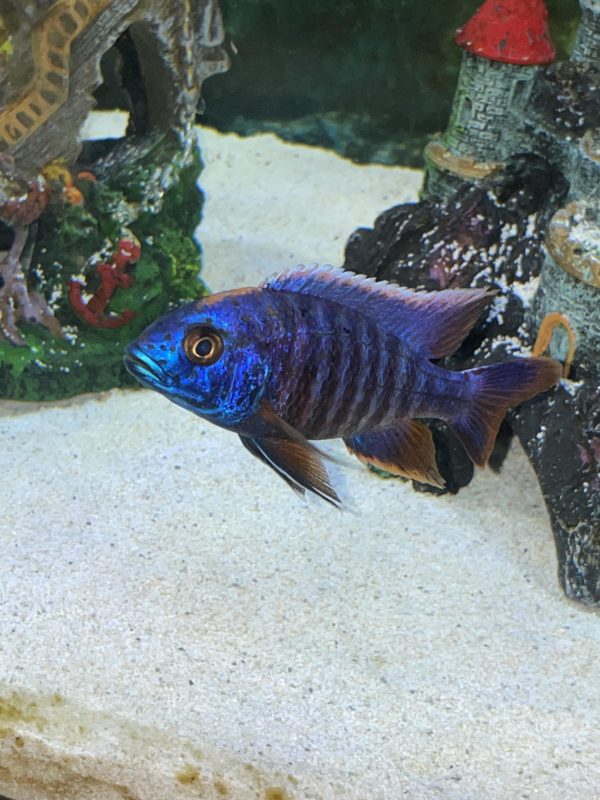
Peacock Cichlids Tank Size and Specifications
Optimum Tank Size for Peacock Cichlids
The recommended tank size for peacock cichlids is 55-100 gallons. As discussed earlier, peacock cichlids actively participate in swimming and occupy the entire tank. Hence, choose a tank that has more width than the tank length.
Tank Shape for Peacock Cichlids
Choosing a rectangular shape tank best suits the peacock cichlids.
Filter Type
You do not necessarily require a filter for the growth of this fish, but to create a movement in the water, you can use the filter.
Substrate
Use a soft substrate to protect the fish gills while hunting. These fishes swim actively, so avoid using rocks and gravel as a substrate—very fine and soft materials like sand substrate suit well as a substrate for peacock cichlids.
How Many Peacock Cichlids In A 55-Gallon Tank?
In a 55-gallon tank, a minimum of 3 peacock cichlids are sufficient.
Water Parameters for Peacock Cichlids
Peacock Cichlids can survive drastic temperature swings. It is necessary to follow the ideal water, temperature, pH, flow rate, and hardness parameters. It is where you’ll find the best deals. Maintaining appropriate values will protect your fish from different ailments.
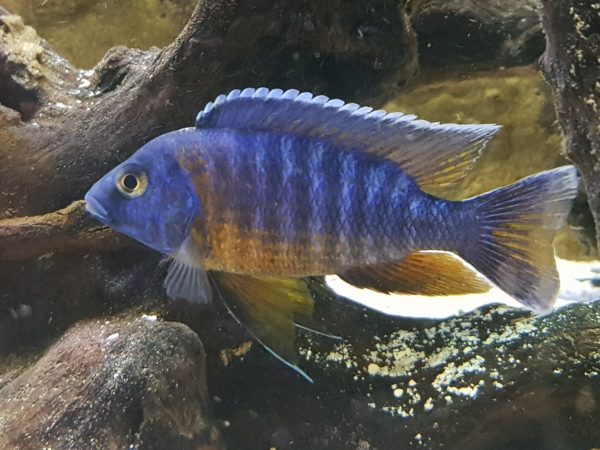
Water Temperature
The ideal water temperature for peacock cichlids is 74-80° Fahrenheit or 23 to 27° Celsius.
pH Level
The perfect water pH level for peacock cichlids is 7.5 to 8.5
Water Hardness
The water should be free from salts, and its hardness should be around 4-6 DH.
Peacock Cichlids Tank Landscape
Peacock cichlids always search to be active either by swimming or searching for food. So, a soft substrate should be placed at the tank bottom since the fish will be in the habitat for their food for the maximum time. Therefore, you need to take care while setting up the tank, avoid placing rocks, pebbles, and gravel as they may cause damage to the fish, and avoid inserting the worst plants into the aquarium.
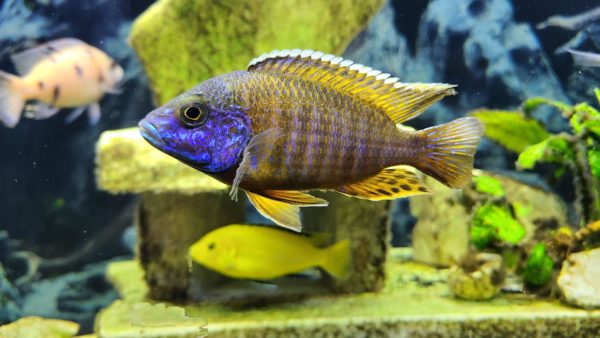
Place the best-suited plants, provide enough lighting to the tank, and decorate the tank to provide a hiding place for the fish. The sections below provide some basic information.
Best Plants for Peacock Cichlids Tanks
Below is the best plant list for peacock cichlids tanks.
- Hornwort
- Fake Plants
- Anacharis
- Duckweed
- Java Fern
Worst Plants For Peacock Cichlids Tanks
Since these fish don’t eat the aquarium plants, there isn’t any information regarding the worst plants.
Decorations for Peacock Cichlids Tanks
It is safe to decorate your aquarium with live aquatic plants without worrying about peacock cichlid fish eating them since the plants serve as hiding places for the fish when they feel threatened.
Lighting for Peacock Cichlids Tanks
The growth of Peacock Cichlids necessitates moderate illumination.
Feeding Peacock Cichlids
Peacock cichlids are predatory fish that feed on invertebrates and insects on the bottom level of their native lake. It makes feeding them an easy task as you can feed them a variety of small insects and other fish feeds. Below are some tips you can follow to feed them in an aquarium setting:
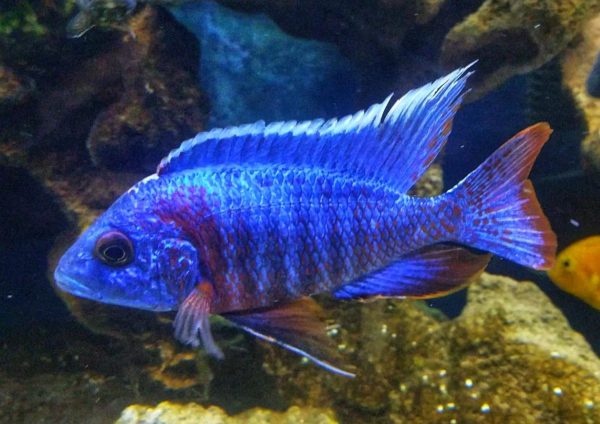
Offer them food that will sink to the bottom of the tank on the substrate. Remember, the fish are bottom dwellers in the wild; they prefer to hunt for food in the lower levels of the lake.
You can offer them insects because they feed on meat but ensure the food can sink to the bottom.
You can offer them frozen or fresh food too.
Best Diet for Peacock Cichlids
The optimum diet for Peacock Cichlids is listed below.
Best food for normal sustenance – Sinking pellet fish.
Frozen bloodworms, brine shrimp, insect larvae, and frozen daphnia are different diets or supplements for optimal health.
How Often Should You Feed Peacock Cichlids?
Peacock cichlids should typically be fed every 2 to 3 times a day in smaller quantities.
Peacock Cichlids Behaviour and Temperament
This fish exhibits less aggressiveness than other cichlids. Of course, certain specimens are much more aggressive than others, so it’s up to you as a fish owner to learn and understand each fish’s temperament. However, you shouldn’t be too concerned about these fishes.
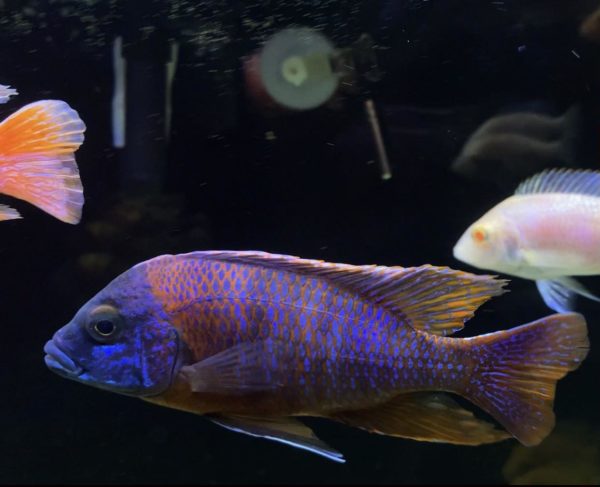
These fish are quite active and spend too much time at the bottom of their native waters digging through the sand and hunting for suitable prey. This behavior may also be seen in captivity, making them fascinating fishes.
Are Peacock Cichlids Lone Or Societal In Nature?
Peacock cichlids are societal, but they show less aggressiveness.
Peacock Cichlids Tank Mates
Ideal Peacock Cichlids Tank Mates
The species which are ideal with the peacock cichlids are mentioned below:
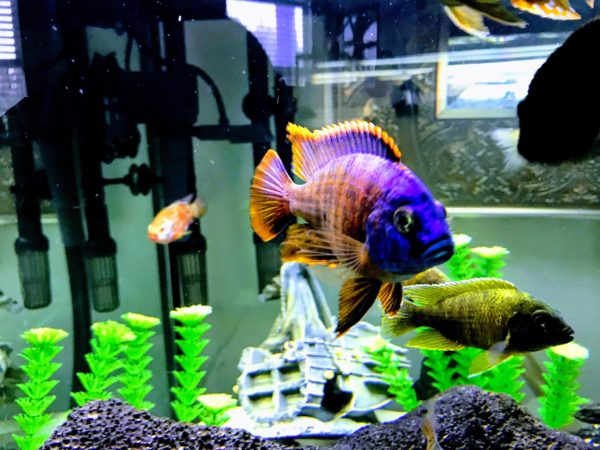
- Peacock Cichlids
- Plecos, Rainbow sharks
- Red tail sharks
- Red eye tetras
- Synodontis catfish
Similar species like peacock cichlids can be kept together in the tank with a male-to-female ratio of 1:2 or 1:4.
Bad Tank Mates for Peacock Cichlids
The following species are not compatible with peacock cichlids:
- Petrotilapia
- Pseudotropheus
- Mbuna
- Labeotropheus
- Utaka Cichlids
- Small fish
- Tiger barbs
- Betta fish
Breeding Peacock Cichlids
The Peacock Cichlids are quite easy to breed.
When it is time for breeding, all you may have to do is place a male-female in a separate tank. The female fish will lay several eggs, fertilized by the male during spawning. The female will care for the fertilized eggs until they get hatched. She may continue providing care to the fry for some more days and later leave them to look after themselves.
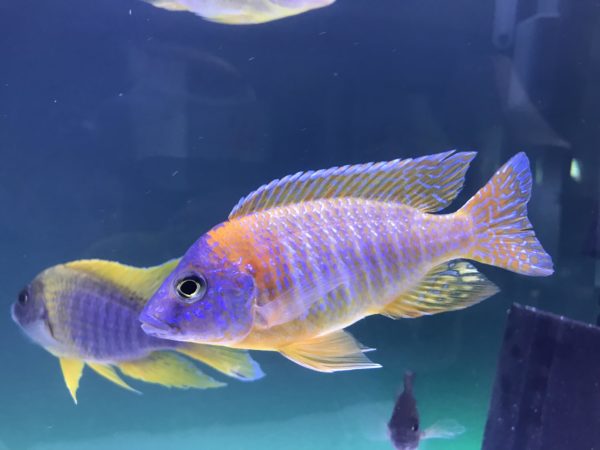
Peacock Cichlids Breeding Level
Easy
Peacock Cichlids Sexual Dimorphism?
To distinguish between male and female peacock cichlids, we should remember the fish’s color patterns.
Male fishes, after maturity, exhibit bright colors, and female fishes will exhibit grey, silver, or brown color.
Peacock Cichlids Common Diseases and their Treatment
Peacock Cichlids encounter common diseases like Malawi Bloat, Swim Bladder Disease, and Mycobacteriosis.
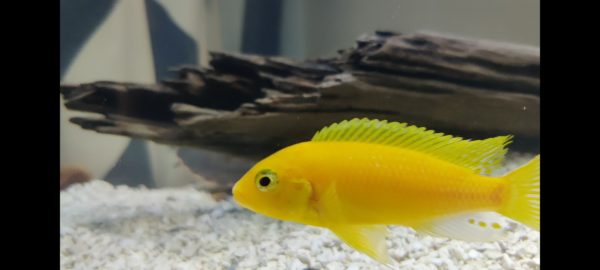
Malawi Boat
Malnutrition or hepatic dysfunction are the causes. Fish attacked with this disease encounters bloated bellies, pale feces, labored breathing, and no appetite. In very rare cases, it leads to the death of the fish.
You can treat by altering the water in the tank every 2 days till the fish gets well.
Swim Bladder Disease
The parasites cause this disease. Fishes affected by this disease cannot swim and float on the water’s surface.
It is advised not to feed rich protein products. To recover your fish, feed them with green peas.
Mycobacteriosis
It is also called fish tuberculosis. Mycobacteria, which are rod-shaped bacteria, cause it. Sunken abdomen, frayed fins, and white speckles on the fish’s body.
Immediately treat the water in the parent tank with antibiotics, and transfer the affected fish to the quarantine tank.
Facts about Peacock Cichlids
- Peacock cichlids are easy to care for. Peacock cichlids seem very attractive due to their bright colors. While hunting for food in the substrate, fish will discharge sand from their gills in the habitat.
- In a cichlid aquarium, overcrowding is almost unavoidable.
- An aggressive fish will have a tougher time identifying a single opponent. It’s still a good idea to try other strategies for reducing hostility initially.
- Males that are infertile or feeble may attend school with girls and have less spectacular coloring.
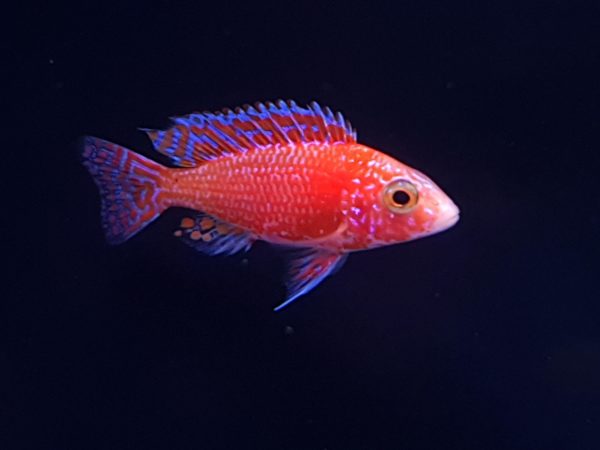
Are Peacock Cichlids Right For You?
Yes, the peacock cichlids best suit experienced aquarists. They can be good for newbie aquarists as well. If your tank consists of diverse territories, avoid putting the Peacock cichlids fish with the aggressive or in a crowded tank.
FAQs
How To Prevent Peacock Cichlid Aggression?
To prevent cichlid’s aggressive behavior, you need to add similar temperament fish and same size fish to the tank. Assume you want to introduce various fish species to your peacock cichlid aquarium.
In such a situation, you must be strict about providing proper feeding sessions, adding territory to tanks, providing enough space, and keeping them from fighting. Peacock cichlids are not quite as violent as their sibling cichlid species, but they may lose their temper if another fish hinders them in the tank.
How To Set Up A Peacock Cichlid Tank?
To set up a tank for peacock cichlids, select a tank of at least 55 gallons. You should maintain the tank’s temperature from around 76o to 82oF. Select a heater to maintain the required temperature in the aquarium for peacock cichlids.
Why Do The Peacock Cichlids Fight?
Peacock cichlids will fight mainly to safeguard their food. Hence it is mandatory to provide a sufficient quantity of food in the tank. The other reason for fighting is the lack of caves and rocks in the tank. They will fight to occupy these hiding spots. Hence kindly fill the tank with good hiding spots.
Are Peacock Cichlids Good For Newbies?
They are calm, handy, and simple to manage. Even experienced fish keepers admire their enthralling activity. In addition, because they live in communal tanks, they have a laid-back personality. As a result, bringing peacock cichlids into the home tank as the first group of fish is ideal for beginners.
Conclusion
I hope you got the information on taking care of and handling the peacock cichlids. These peacock cichlids species add beauty to the aquarium with their stunning appearance. This fish best suits experienced and newbie aquarists.
Peacock cichlids tend to swim always, so they require a lot of space in the aquarium. Hence avoid keeping the fish in a crowded aquarium. If you cannot stabilize the aquarium, get the more habituated fish to normal conditions.
Please feel free to share any questions with us if you have any questions.
No related posts.
